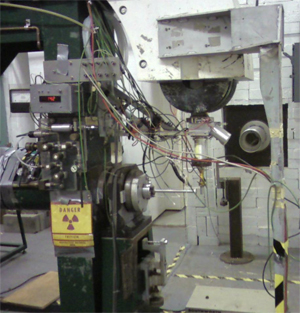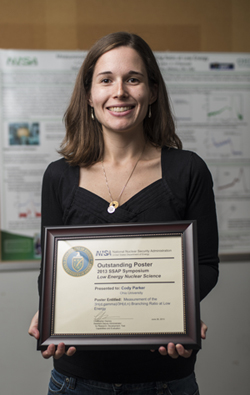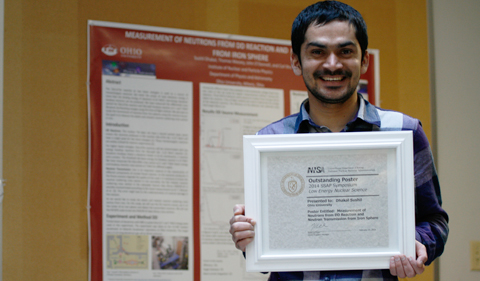Dr. Carl Brune, Professor of Physics and Astronomy, and graduate students Youngshin Byun, Sushil Dhakal, Cody Parker, and Anthony Ramirez attended the 2013 Stewardship Science Academic Programs (SSAP) Annual Review Symposium June 27-28 in Albuquerque, NM. All of the students presented posters at the meeting. These posters were judged by committees of eminent scientists in the field.
Parker’s poster on “Measurement of the 3H(d,γ)/3H(d,n) Branching Ratio at Low Energy” was chosen from among 19 entrants as the Outstanding Poster in the category Low-Energy Nuclear Science.
Parker’s poster described her work measuring the fraction of deuterium-tritium fusion reactions in which a gamma ray is emitted. This ratio is not well known at present. Obtaining better data on it is important because the number of gamma rays detected at “inertial confinement” fusion facilities like the National Ignition Facility reveals the number of fusions that occurred.
For her M.S. work, Parker did a preliminary measurement of this ratio at the John E. Edwards Accelerator Laboratory, which has unique capabilities that help eliminate backgrounds that would otherwise contaminate the desired signal. She found that 7+/-2 in 100,000 fusions resulted in the emission of a gamma ray: one of the most accurate measurements yet of this small branching ratio.
She is now working toward her Ph.D., which focuses on refinements of this measurement that will result in an even more accurate number.

The swinger beamline, target area, and
collimated, concrete-shielded tunnel entrance in the Edwards Accelerator Lab.
Parker’s Abstract: The 3H+d→n+α reaction provides the easiest approach to achieving fusion in the laboratory. At the National Ignition Facility (NIF), lasers are used to drive inertial confinement fusion (ICF). A major goal of this facility is the achievement of ignition, the generation of more energy by nuclear fusion than put in by the lasers. The 3H+d→5He+γ reaction takes place at the same time as 3H+d→n+α. Providing a better measurement of the ratio of the rates at which the two reactions occur, i.e., the 3H(d,γ)5He/3H(d,n)α branching ratio, is important because the number of γ’s (gamma rays) detected at NIF reveals the number of fusions that occurred. The γ’s are useful for diagnostic purposes because they come out of an implosion nearly unscattered, as opposed to neutrons which interact often, thereby losing energy, in the dense fuel. The γ’s also travel faster, and therefore arrive sooner, than the neutrons, allowing them to be identified separately due to their different velocities over a set detector distance, or time-of-flight. In addition to the ICF application, studying the 3H+d→5He+γ reaction leads to a better understanding of the properties of the unbound 5He “nucleus.” Over the last 50 years, several groups have published measurements of the 3H(d,γ)5He/3H(d,n)α branching ratio, with results differing by a factor of approximately 100.
This thesis reports on a new measurement at the John E. Edwards Accelerator Laboratory, whose swinger beamline and concrete-shielded time-of-flight tunnel provide unique capabilities that help eliminate backgrounds which otherwise contaminate the desired signal. The measurement used a 500- keV pulsed deuteron beam incident on a solid titanium tritide target. The time-of-flight technique was used to distinguish the γ-rays from the neutrons in the detectors. The branching ratio was measured to be (6.9±1.6)×10-5.




















Comments